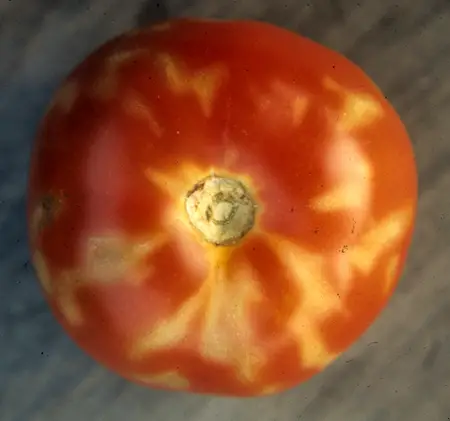Gray Wall on Tomatoes: Blotchy Ripening on Fruit
Since 2010, Tomato Dirt has garnered 4.8+ million views, making it the web’s leading online source for growing tomatoes in the home garden. Award-winning writer and Tomato Dirt owner Kathy Widenhouse has helped thousands of home gardeners grow healthier tomatoes. Be one of them when you get Tomato Dirt’s Growing Guide here.
Updated 7.9.24
Gray wall on tomatoes, also called blotchy ripening, is a not a disease or the result of a pest infestation. Rather it’s a physiological condition associated with environmental factors. The condition affects tomato fruit during the ripening process. Stems and leaves do not show symptoms.
What it looks like
Tomatoes look splotchy, mottled or unevenly ripened. Outward grayish splotches on tomato surfaces may even collapse inward – thus the condition’s name. The inside of an affected tomato may also have grayish, yellowish, brownish, or greenish patches.
When does gray wall affect my tomatoes?
Blotchly ripening develops most often on green tomatoes during the ripening process. Varieties which are susceptible to tomato mosaic virus are also more likely to exhibit symptoms.
What causes gray wall?
Several environmental factors can contribute.
- Weather conditions. Extreme heat, high humidity, and fluctuating temperatures stress plants.
- Shade. Overcast skies during hot weather, fog, clouds, and excessive foliage promote uneven ripening.
- Excessive nitrogen. Nitrogen stimulates leaf growth. Tomato plants that have been over-fertilized or have been fertilized with a product high in nitrogen produce too many leaves. The extra leaves shade ripening fruit, contributing to the problem. Often low potassium and low boron promote to uneven ripening, too.
- Overly wet soil can also contribute to inconsistent ripening.
How to distinguish it from tomato mosaic virus (ToMV or TMV)
Tomatoes affected by gray wall exhibit symptoms on fruit alone. Tomato mosaic virus causes mottling and spotting on both fruit and foliage.
How to treat and prevent it
More about problems on tomato fruit
How to identify, treat, and prevent problems on tomato fruit ...
What causes mealy tomatoes and what to do about it ...
Tomato anthracnose: how to identify and treat it ...
Tomato sunscald: why too much sun can be hazardous to tomato health
Why a tomato cracks and what to do about it ...
Help! My tomatoes have green shoulders (yellow shoulders) ...
Why tomatoes can develop a hard, white center ...
Blossom end rot: how to identify, treat, and prevent it ...
Get more tips on our Tomato Problems Pinterest board.
Return from Gray Wall in Tomatoes to Tomato Dirt home
As an Amazon Associate and Rakuten Advertising affiliate I earn from qualifying purchases.
SHARE THIS PAGE:
FREE! 10 Must-Know Tomato Growing Tips: 20-page guide
Get yours here:





New! Comments
Have your say about what you just read! Leave a comment in the box below.